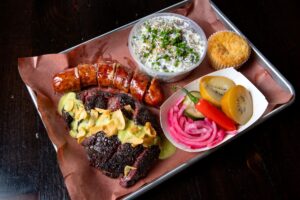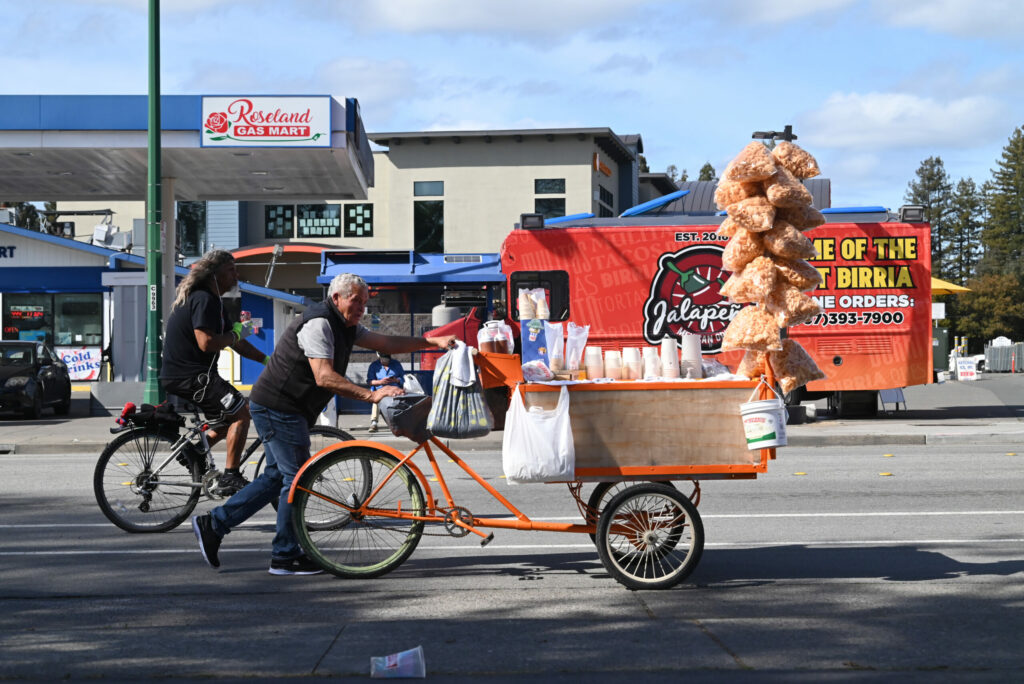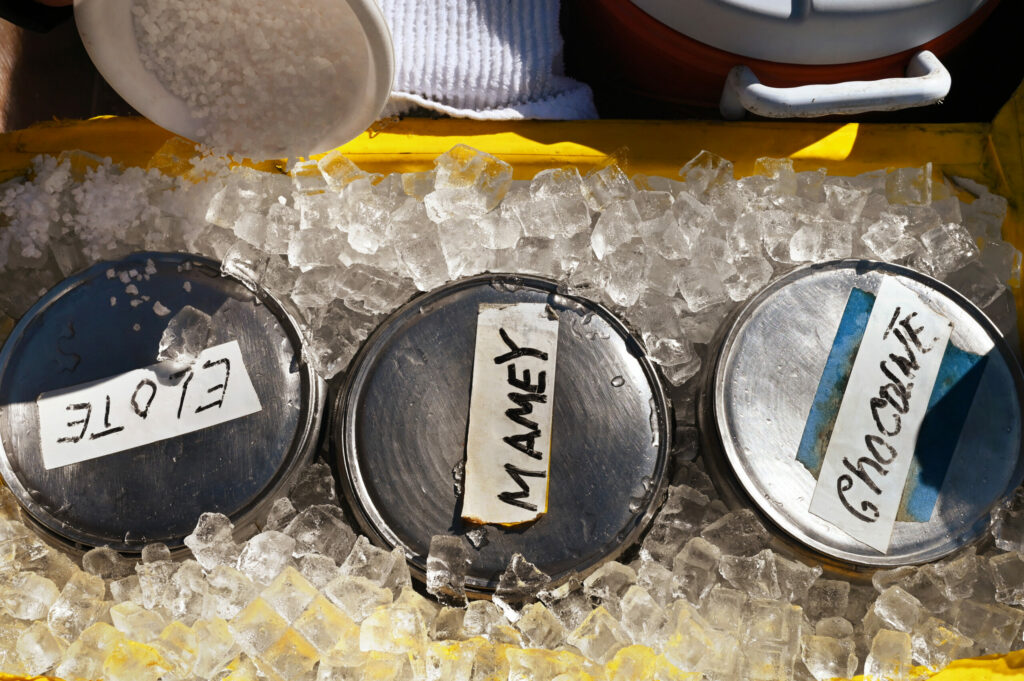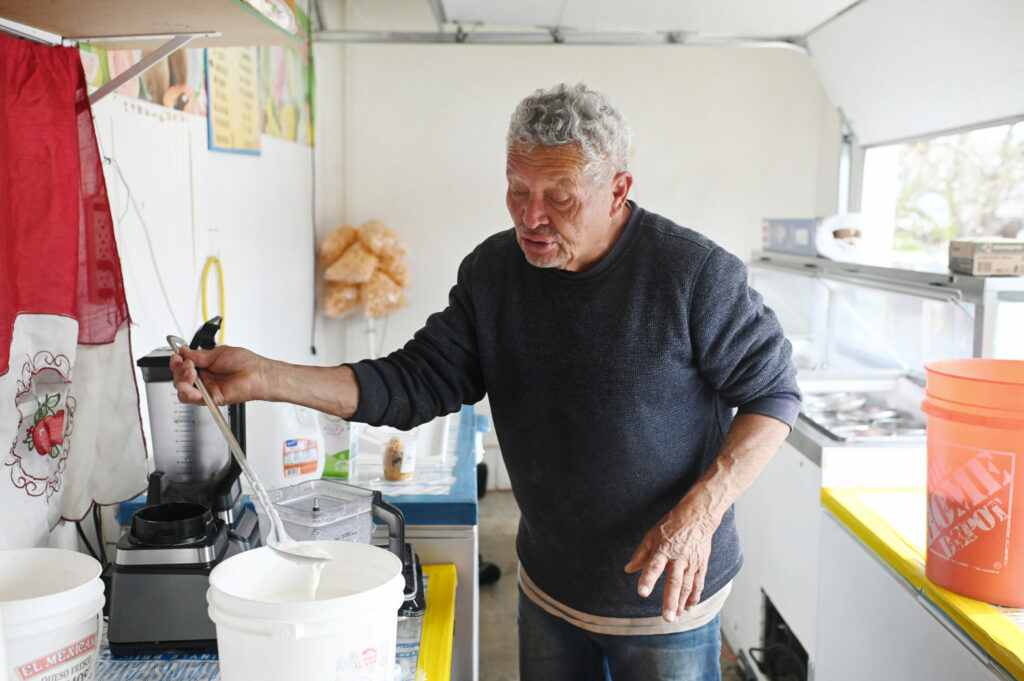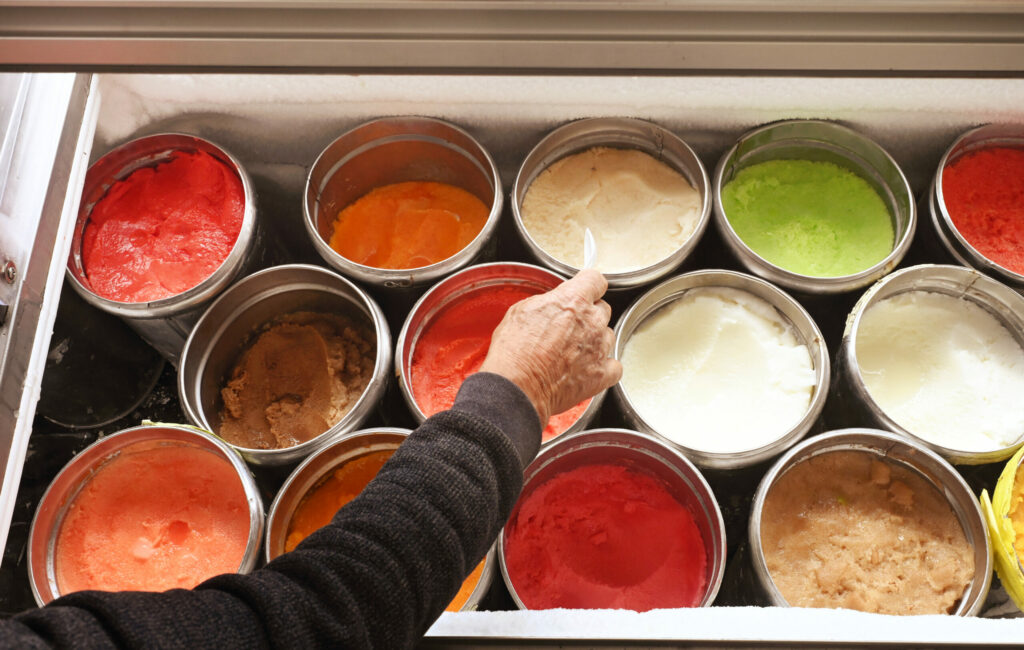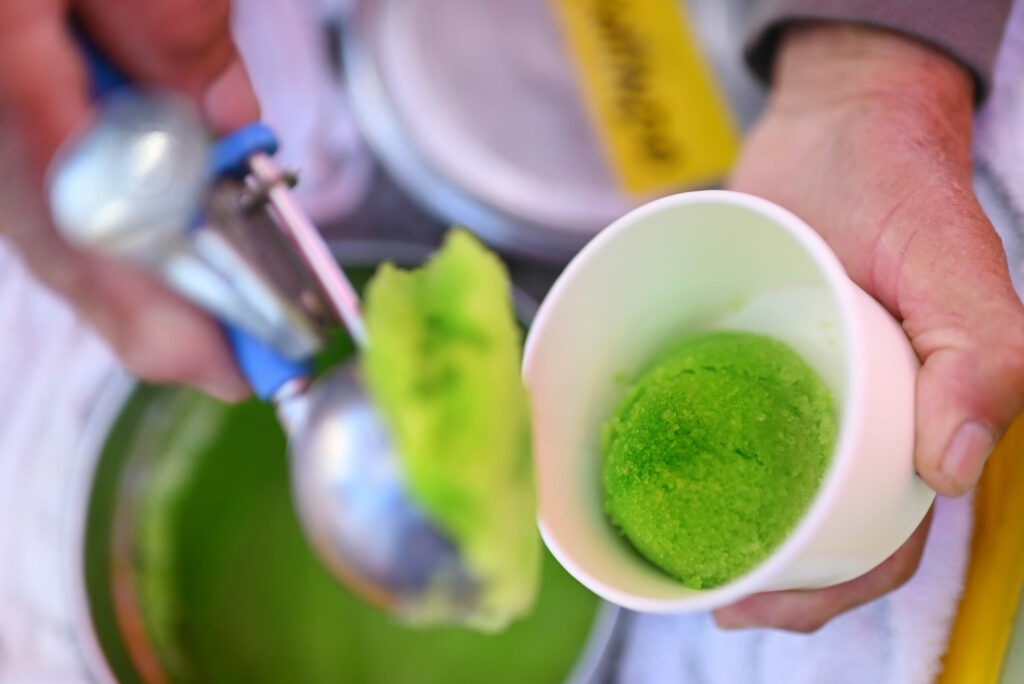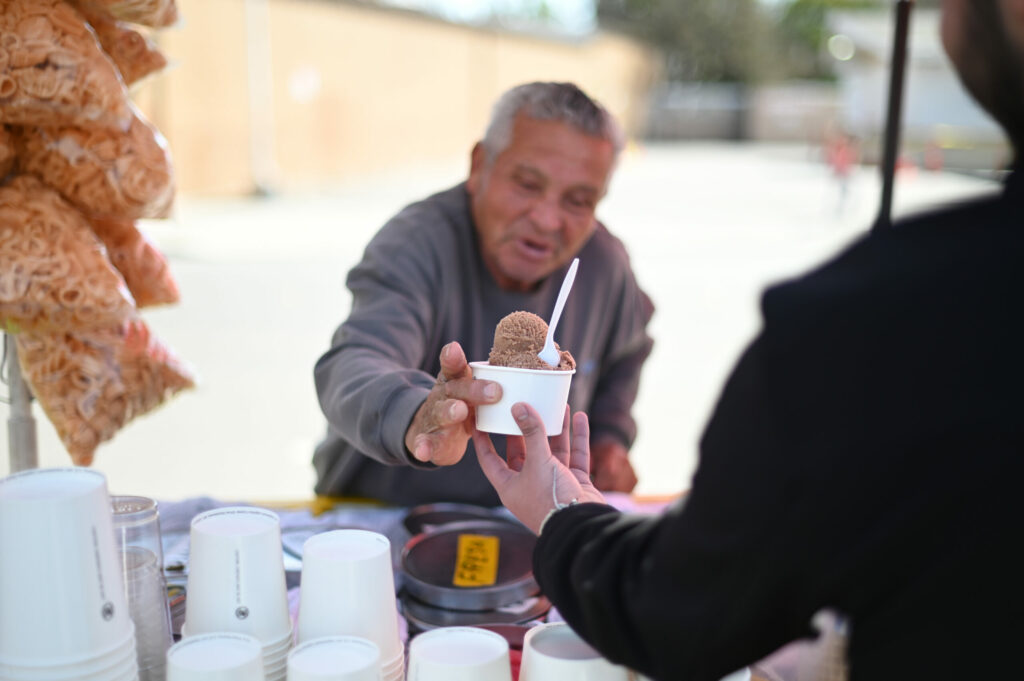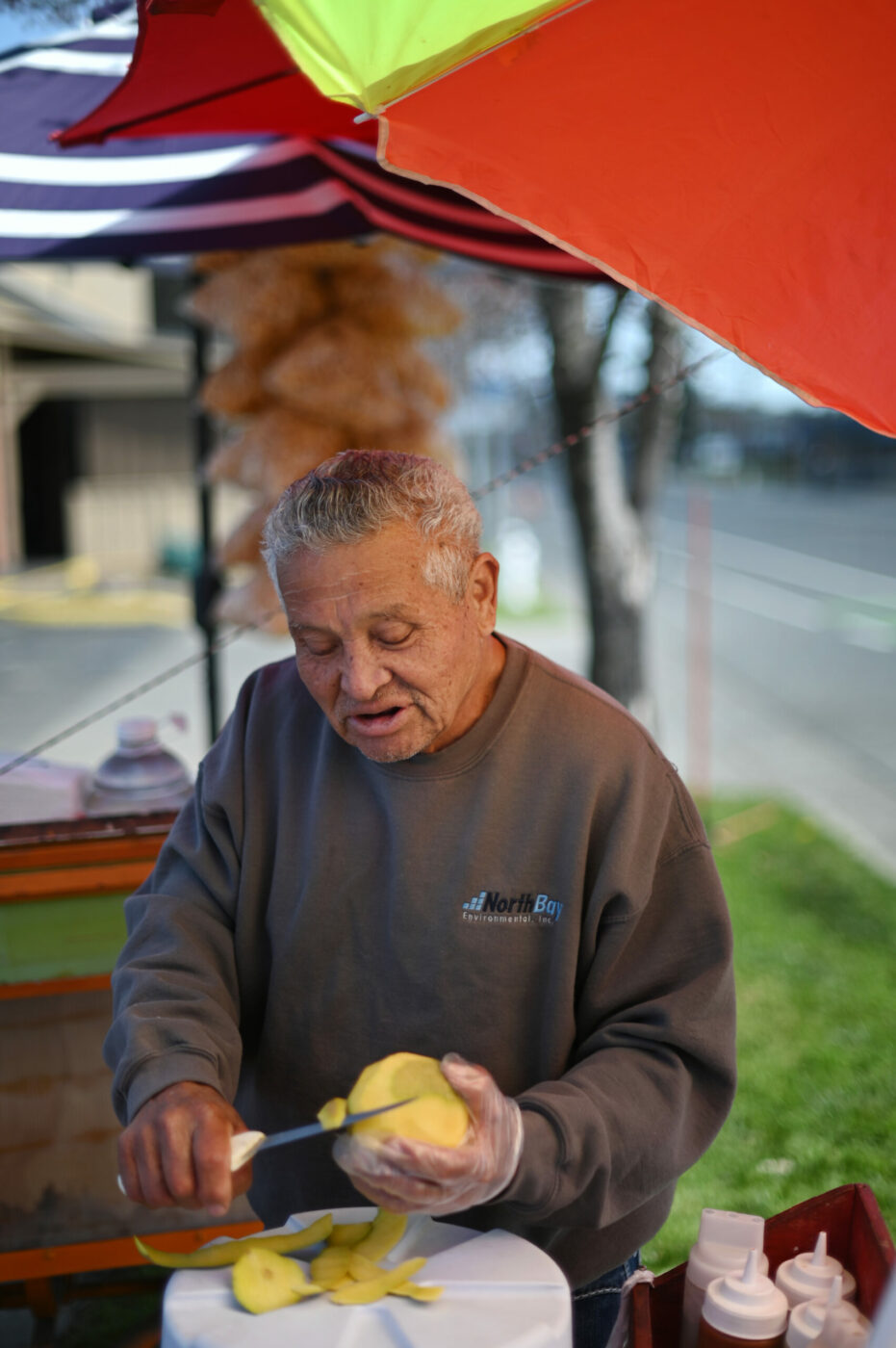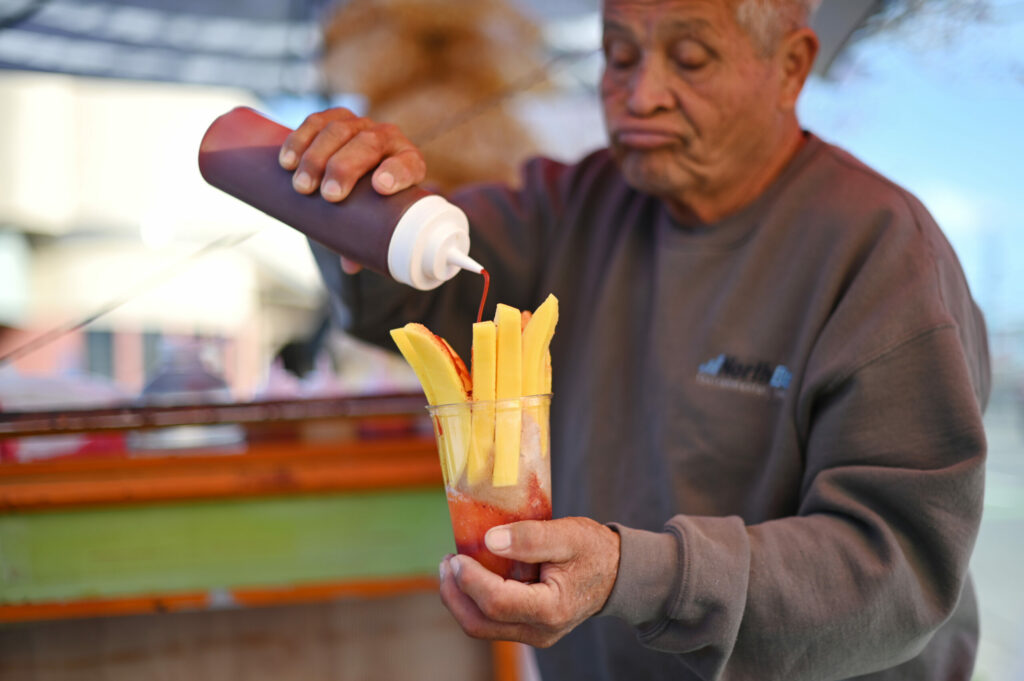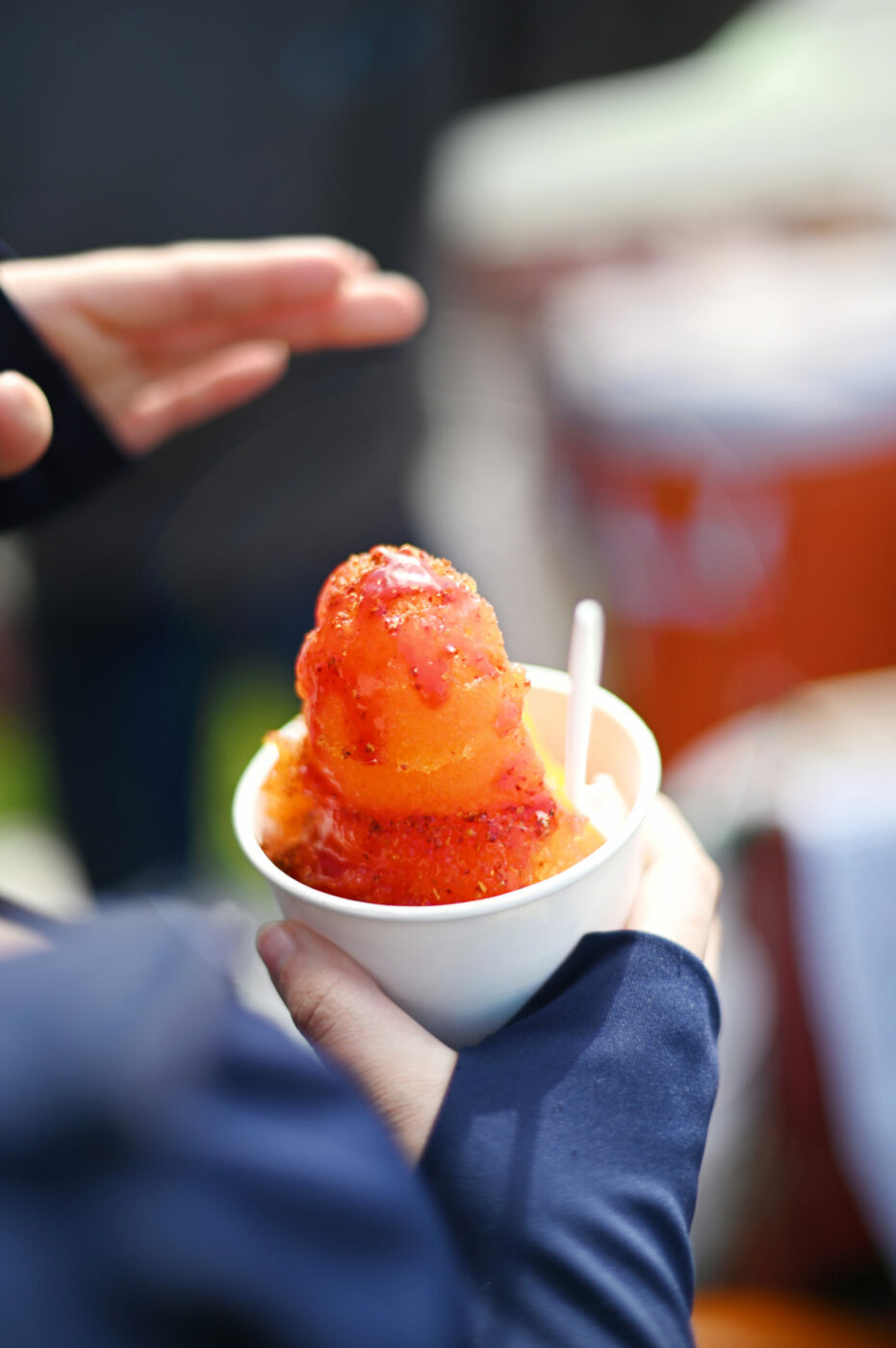Lea el artículo en español aquí.
The ice cream man is ready to pack up and move to his next spot. It’s 2:30 on a Friday afternoon, and so far, he has sold only 10 cups of his homemade treats. Looking up at the sun, he wipes sweat from his forehead with a towel. He’s just lugged a large bag of ice on his shoulder across a parking lot. Now, using a wooden stick, he packs ice deep in the crevices between 2-gallon buckets of ice cream, sprinkling rock salt over the top to make it last longer.
But before he can roll out his cart, more customers finally come by his current spot in a fast-food parking lot near Santa Rosa’s Sebastopol Road. Olivia, who works at a discount store nearby, walks over on her break. “I don’t have my purse with me,” she says, apologizing. The vendor just smiles, telling her not to worry.
Scooping up her favorite flavor, mango, he sprinkles Tajin and drizzles tangy chamoy on top until it looks like a blood-orange sunset. He knows she will pay him the next time he sees her. She’s been eating his ice cream for more than a decade, she says. It’s the same regional style of ice cream — often called nieve de garrafa after the small, wooden carafes traditionally used in homemade ice cream churns — that she enjoyed as a kid growing up in a tiny beach town on the Mexican coast.
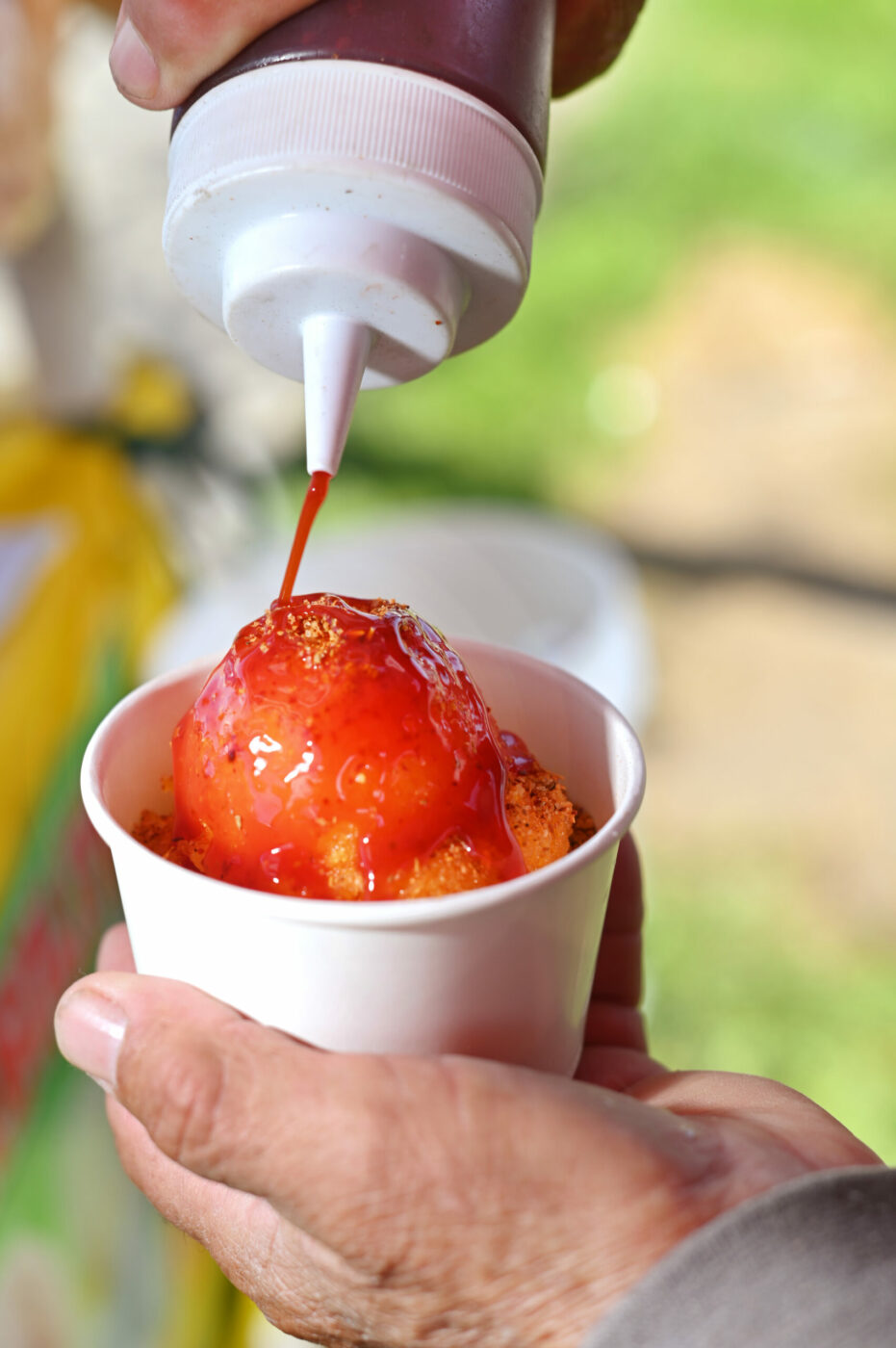
Loaded with fresh fruit bought from local markets, his sweet frozen concoctions are made with whole milk, evaporated milk and half-and-half. They’re often icier and less creamy than American ice creams, with a texture that falls somewhere between sorbet and snow cone. They are alive with flavors you rarely find at traditional grocery stores, including elote, a popular sweet corn style that takes all day to cook; mamey, a Central American fruit with hints of sweet potato and caramel; queso, made with Philadelphia cream cheese; tuna (prickly pear cactus fruit); and chongo, a milky, cinnamon-spiced version of the popular chongos zamoranos dessert from Michoacán.
It makes a difference that he takes the time to make the ice cream with his own hands, says Olivia, before she heads back to work.
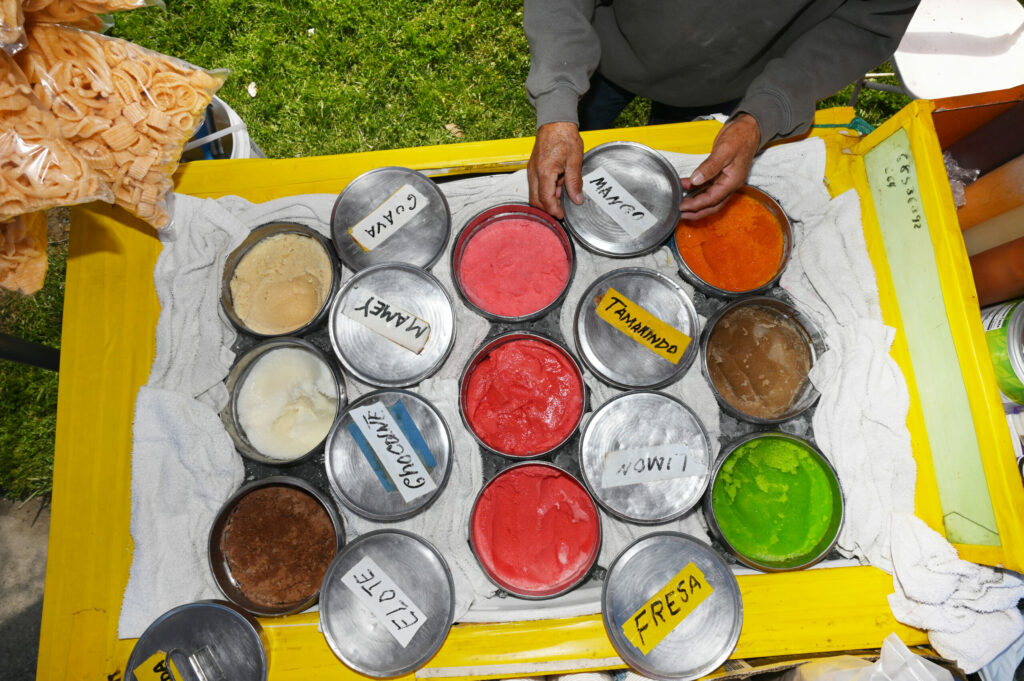
ALTHOUGH THE VENDOR has heard this compliment before, he still laughs and shakes his head, almost embarrassed. His thin gray mustache and wavy silver hair fit his patient demeanor. When he smiles, his mouth opens wide and his eyes close to a squint. In his early 70s, he is known by the honorific Don, or elder. But the children who flock to his cart from all over Roseland call him señor de las probaditas, or “the man who gives little tastes.” (We are not using his name given concerns about potential immigration enforcement activity.)
The vendor carries several hundred plastic spoons in a small plastic bag that hangs from the cart. He pulls one out when a boy approaches to ask for a taste of peach ice cream. After a few more tastes, he settles on chocolate. His sister chooses mango, and their mother, Ana, gets elote, which is also his own favorite. Ana says the milky, sweet corn flavor reminds her of the cobbled streets of Santa Clara del Cobre in Michoacán, where she was raised.
“I remember as a kid, when we would get out of school, the ice cream man would be there waiting every day,” she said. Her favorite day of the year was April 30, a holiday celebrated throughout Mexico as el Día del Niño, when the ice cream man would give all the kids in the neighborhood free ice cream.
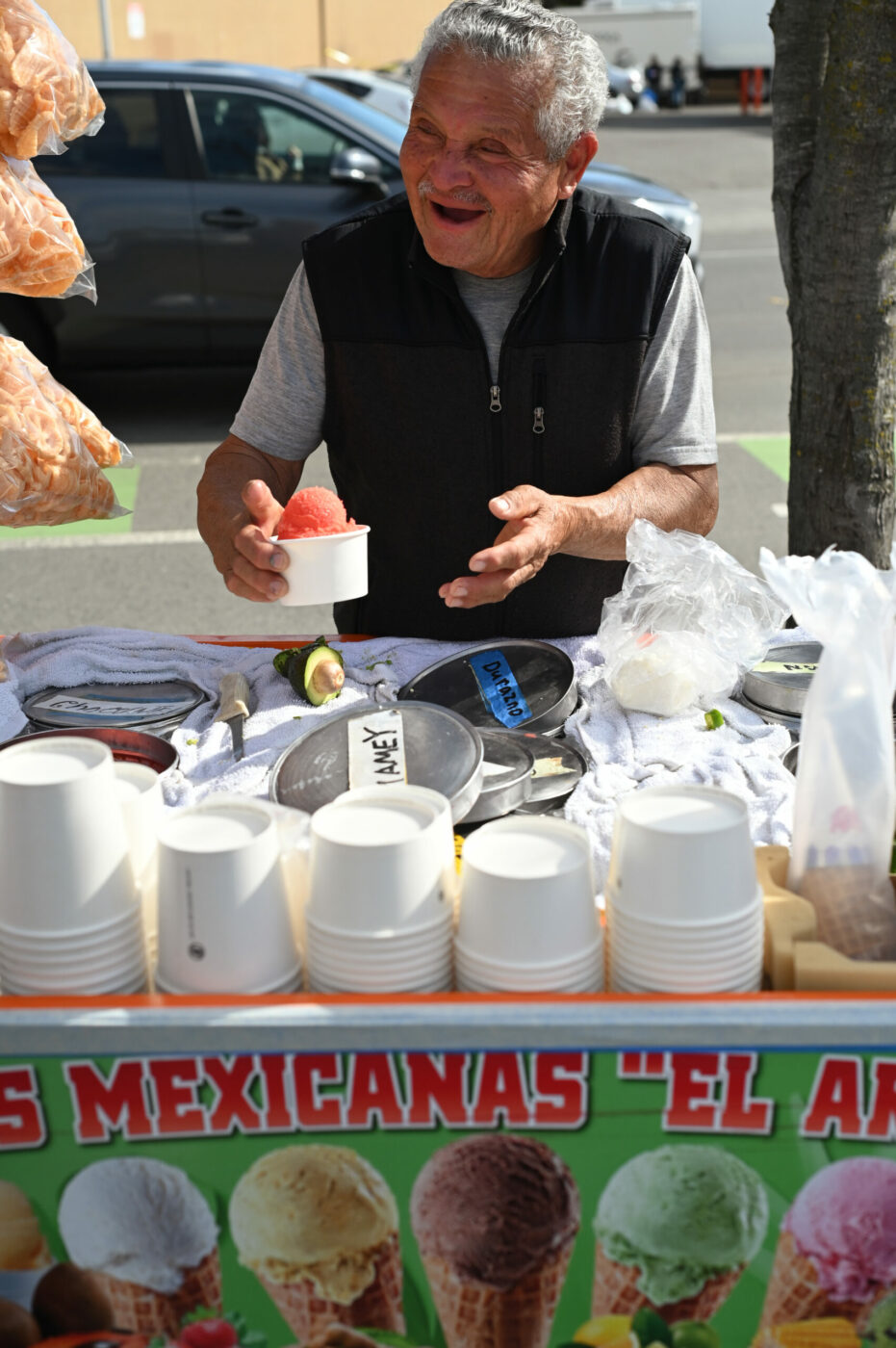
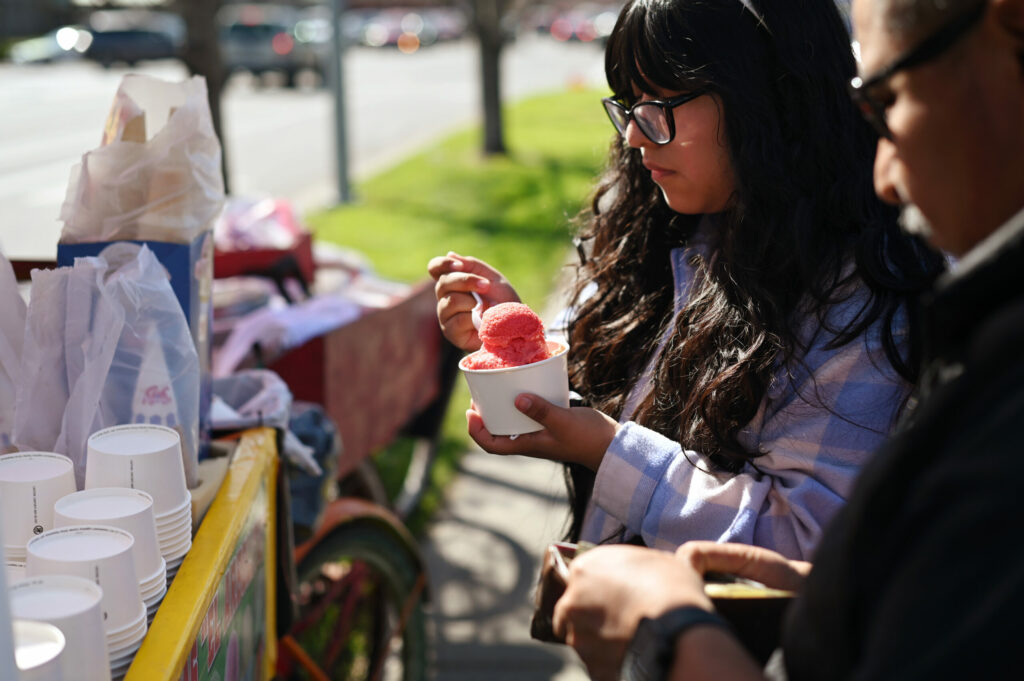
A small player in a close community that prides itself on resilience, he is one of many street vendors and small business owners, both licensed and unlicensed, who drive the economic engine of Roseland — a neighborhood built on street life and market culture that has as much to do with the way commerce works in Mexico as it does in America.
Everything he has, he has made on his own. His ice cream, his cart, his innovation and spirit of survival. But he is not alone. The same spirit lives in the woman selling flats of oranges in the big-box parking lot, in the tamale-cart man selling to construction workers at sunrise, in the snack sellers who roll by youth soccer games at the park on Saturdays.
But these are different times. Since January, as the Trump administration continues to order immigration enforcement actions in communities around the country, the specter of deportation hangs heavy. “The way people feel is that it’s not a matter of if, it’s a matter of when,” says Marcos Suarez, the business diversity program manager for the Sonoma County Economic Development Board. Over the past few months, Suarez says he has noticed fewer street vendors along Sebastopol Road, especially those who sell from their cars in parking lots.
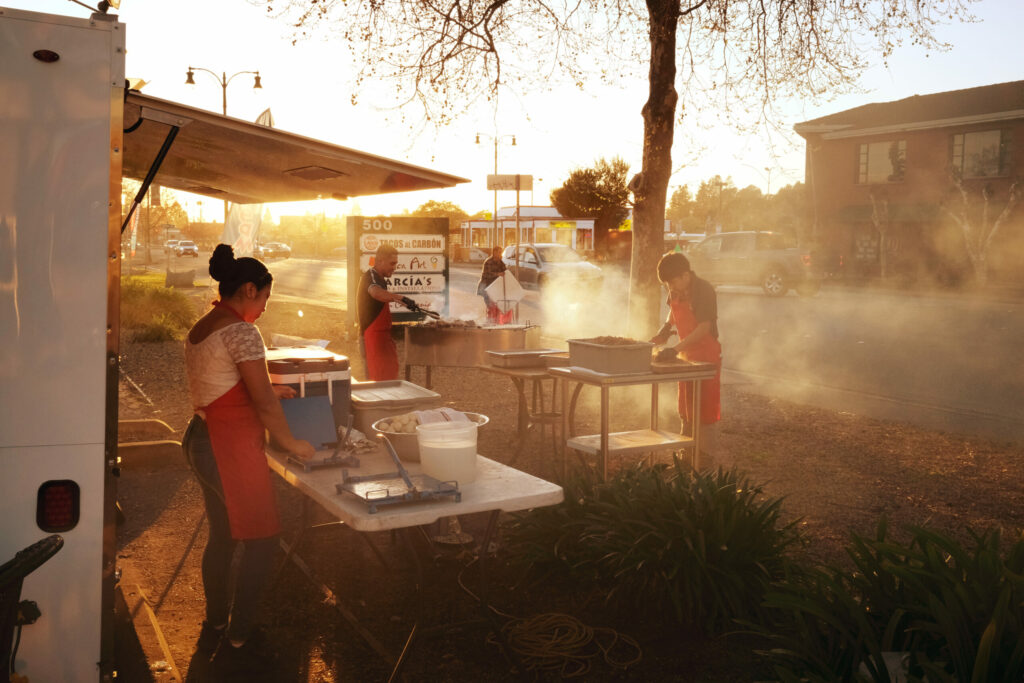
The vendor says he worries that ICE might make a sweep through Roseland. But they’re supposed to be going after criminals, he tells himself. “I don’t get in trouble. I don’t drink and drive. I don’t even own a car. I only drive a tricycle.”
For many, the neighborhood’s food culture is a lifeline in difficult times. Suarez says traditional cuisine like ice cream triggers memories for people all along this stretch of Sebastopol Road. It might be the menudo at a particular restaurant, he says, or a bottle of authentic Mexican Coke made with cane sugar, or the herbal remedy cola de caballo, often taken for indigestion or infections. “You gotta understand, there are a lot of people here that haven’t gone home in 30 or 40 years, because they can’t,” says Suarez. “They could, but they won’t be able to come back. So, anything that reminds them of Mexico is very special to them. It’s nostalgia.”
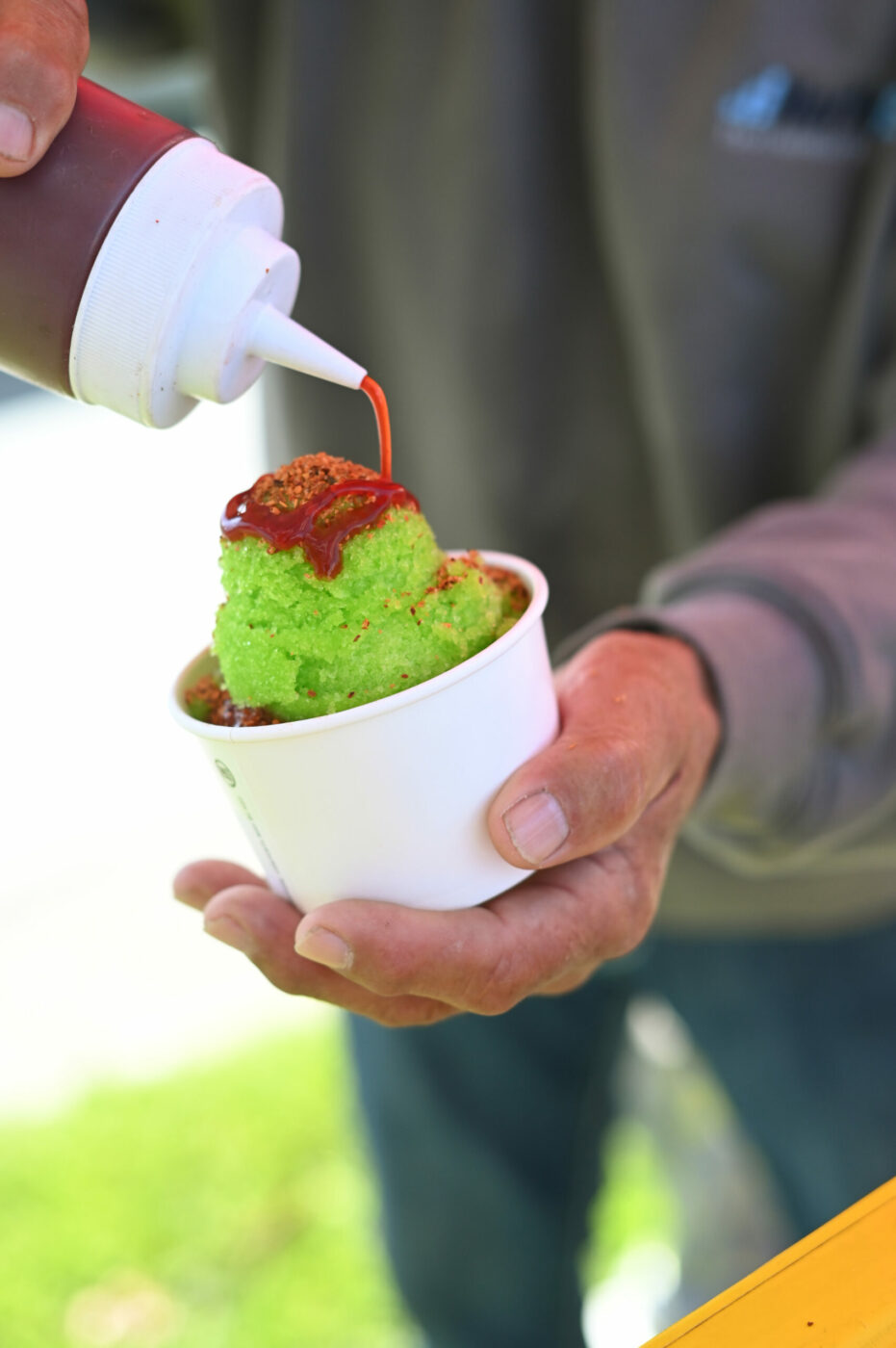
THE FIRST FLAVOR of ice cream he ever tasted was limón. The vendor is the second youngest in a family of 11 from Villa de Ayala, a small town in central Mexico not far from Cuernavaca. One year, on Mexican Independence Day, a school parade led to the town plaza where a vendor gave free ice cream to the kids. The only flavor was limón, dressed up with a bit of Parmesan cheese and a thin galleta Maria. It was almost magical, the way it melted in his mouth, he remembers.
His parents grew corn, beans and tomatillos, selling their produce at the local market. He made it as far as the fifth grade before he quit school to start working on the farm. When he was 18, he followed his sister to Mexico City. After working in a Pascual Boing soda factory, he learned to make limón ice cream from a recipe he got from his younger brother. Listening to feedback from customers, he continued to experiment, eventually perfecting other flavors like strawberry and chocolate.
Five decades later, ice cream is a means of survival. Since he arrived in Santa Rosa in the mid-1990s, he’s washed dishes, cooked at restaurants, and worked a warehouse gig. But ice cream is the only job where on a busy day, he can make over $1,000, selling $6 and $8 cups along with bowls of esquites street corn and mangonadas with sliced fruit. But those flush days are few and far between — a typical day nets more like $200, and margins are tight. He estimates he spends $1,600 a month in local markets on fresh fruit, evaporated milk and other ingredients.
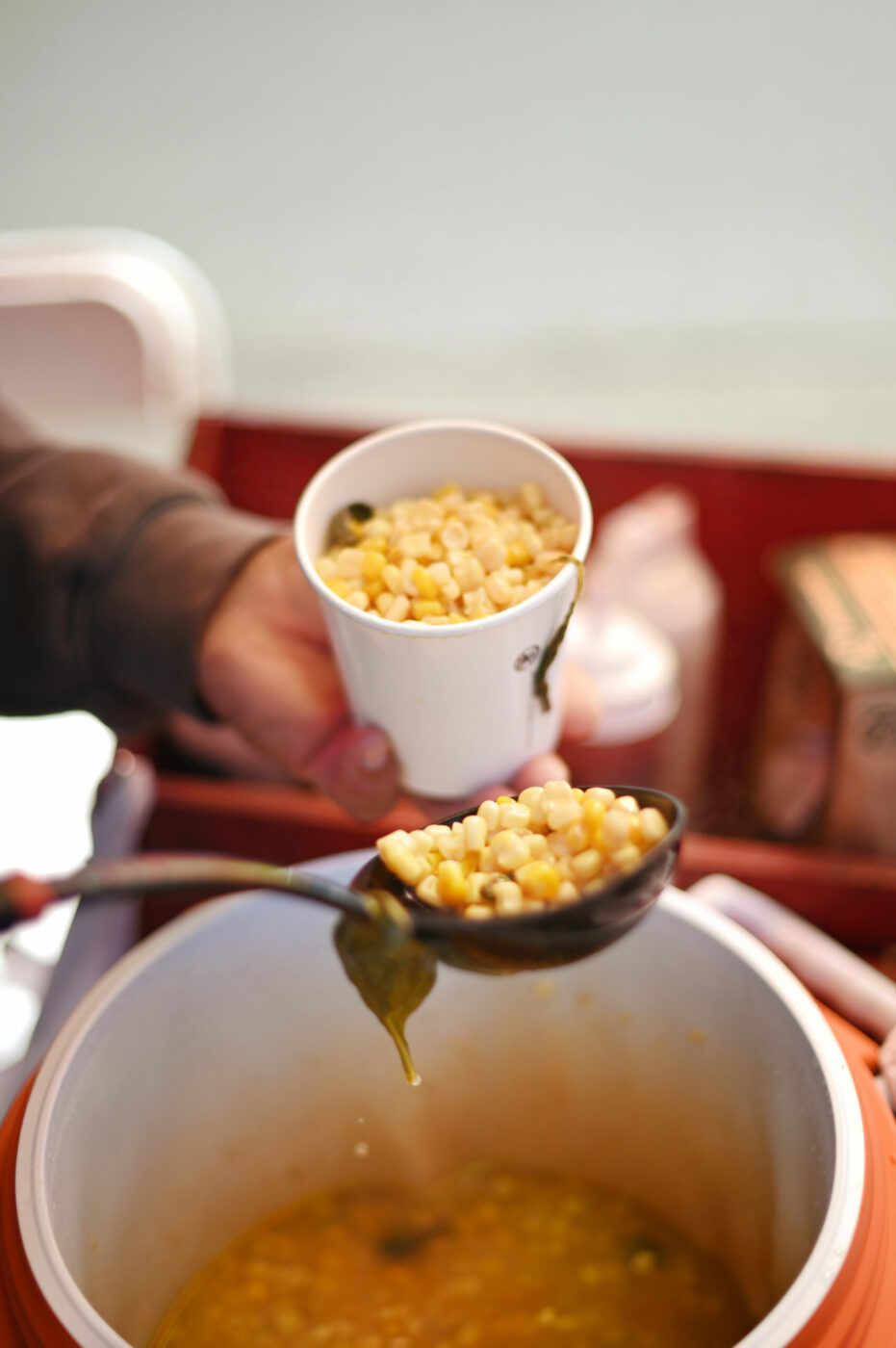
Over the years, he’s learned to watch his back. Four years ago, he was pushing his cart home one night, when a man ran up to him with a gun, yelling “Give me the money!” When the gun, which he later realized was likely fake, wouldn’t fire, the man chased him around the cart a few times before hitting him with the stick he uses to pack ice around his buckets. He wound up in the hospital, with several staples in his head — but “he never got my money,” he says with a smile.
THE VENDOR USED TO SELL alongside his grandson, often stopping with him in the shade of a short, scrubby pine next to a soccer field. These days, more than 15 years later, he is alone, parked under a different tree near a fast-food drive-thru.
Some days, he trades ice cream for a hamburger and fries at the fast-food joint, but this day, he has other plans. As he packs up his cart to head out, his destination is another small pine at the other end of Sebastopol Road. In black running shoes, jeans and a fleece vest, he will push the cart nearly 3 miles by the end of the day.
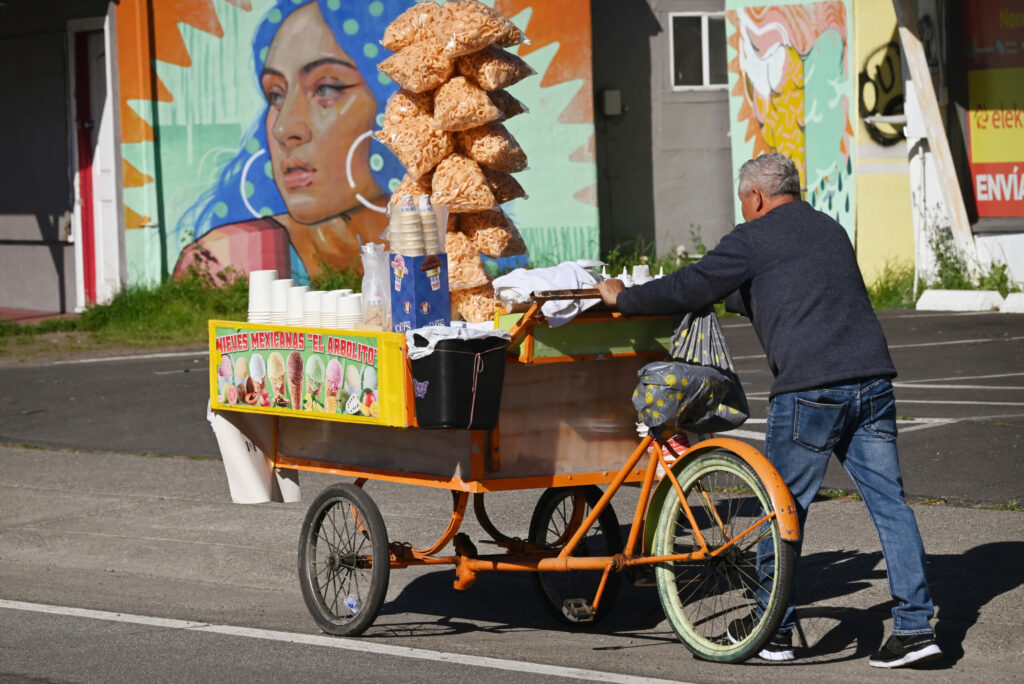
He secures his wares like a rag-and-bone man. A small trash can is tied down with a bungee cord. An old queso fresco bucket holds his ice-cream scoops. The tall pole hung with bags of chicharrones de harina teeters as he leans into the cart, pushing with all his might to get it rolling. He made the cart by welding the back half of a bike to a two-wheeled trailer. A tricycle of sorts, it looks like he could hop on the seat and ride it, but he says it weighs several hundred pounds and is too hard to pedal and steer. Instead, he pushes it on foot, sometimes kicking out the back wheel, almost like a boat rudder, when he needs to turn sharply.
By this time, there’s a Friday afternoon vibe in the air. Kids are out of school. Ranchera music pulses from a passing car. Construction crews getting off work early carry cases of Modelo across a parking lot. Rolling past a brick-and-mortar ice cream parlor (what he calls “factory-made ice cream”), he turns right on Sebastopol Road.
Roseland’s main drag is bustling with auto shops, jewelry stores that double as soccer shops, palm readers, Mexican restaurants and more than 20 food trucks. In the late 1800s, long before the existence of Highway 12, this was a gravel road, the only east-west route between Santa Rosa and Sebastopol. Now it’s the heart and soul of Mexican culture in Santa Rosa. Like the Mission in San Francisco or Boyle Heights in Los Angeles, the color palette seems to change on this side of town, whether it’s the bright pastels of quinceañera dolls in the windows of a party supply store, the soft blue halo of a sidewalk altar to Our Lady of Guadalupe, or the red clay hues of the Rancho Mendoza supermercado.
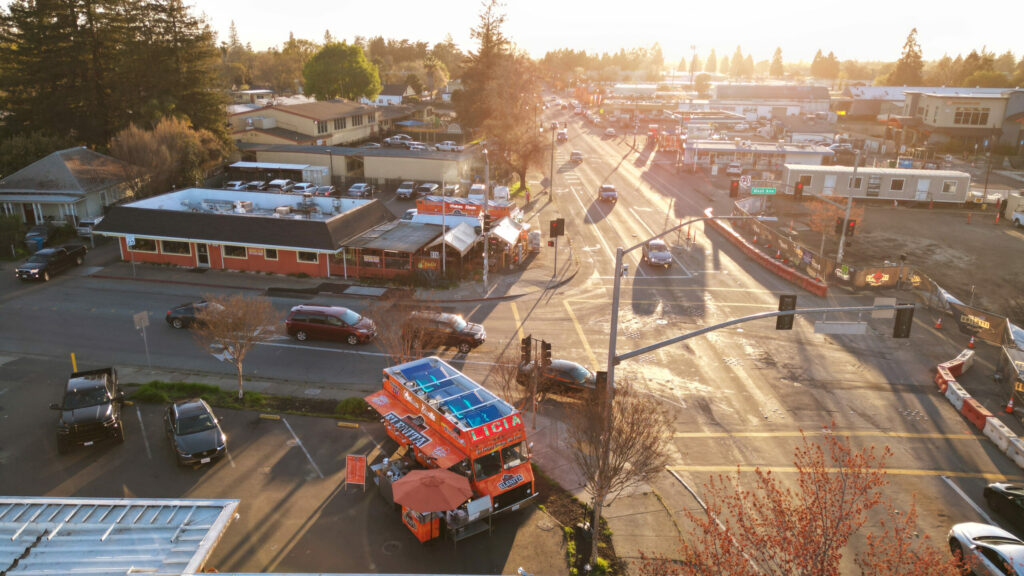
Legend has it that botanist Luther Burbank told an early landowner he should call the flat, western ranchlands Roseland for the clusters of roses that bloomed in front of farmhouses. The name stuck. But Pruneland might have been more appropriate, since prunes were far more plentiful. “I remember when it was all prune trees where FoodMaxx is now,” says Ignacio “Don Nacho” Alvarez, longtime owner of Joyeria Maria along Sebastopol Road, across from the former Mitote Food Park.
Not quite downtown, and not quite the suburbs, Roseland has always been “the west side of town.” And there’s history to prove it. On a Saturday morning in June 1876, an angry mob broke into the Santa Rosa jail and seized a 58-year-old man accused of murder, driving him in a wagon “about a mile out of town on the Sebastopol Road,” according to newspapers, where they hung him from a tree. More than a century later, in the same part of town, angry protestors held several rallies in front of the former Dollar Tree on Sebastopol Road after 13-year-old Andy Lopez was fatally shot by a sheriff’s deputy. More recently, vocal crowds rallying for “A Day Without Immigrants,” marched here from Courthouse Square.
He bounces back and forth between the sidewalk and a no man’s land alongside the busy road, a path he traces almost every day. He doesn’t know it, but he’s following in the footsteps of a fellow ice cream vendor from another era: Feliciano Benincasa, who started selling out of his white Dodge truck in the 1940s, before becoming one of the most popular business owners in Santa Rosa.
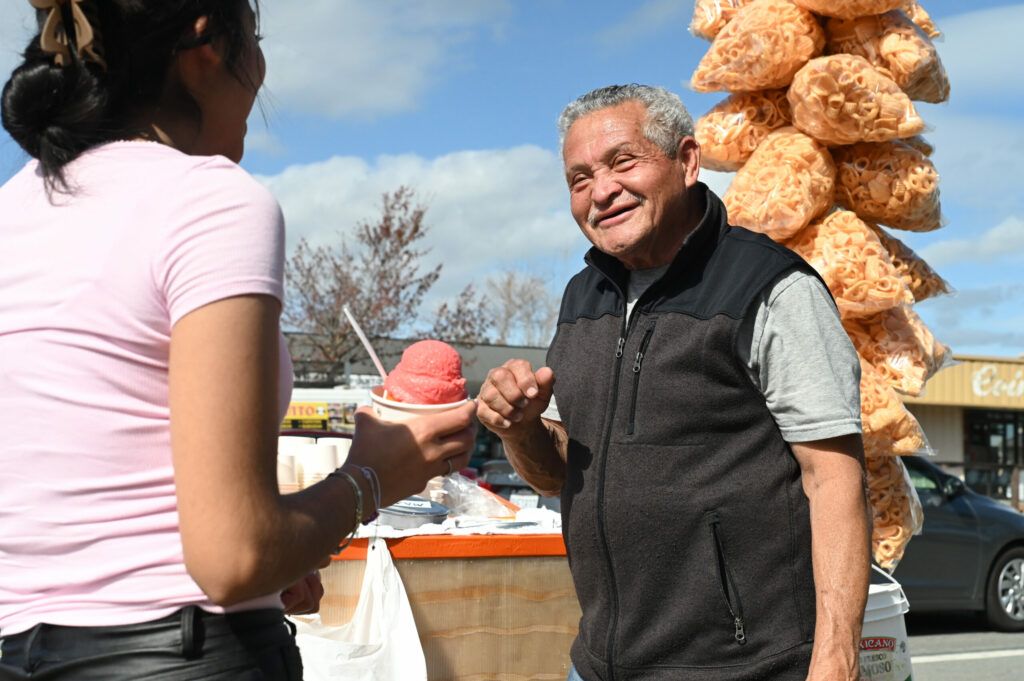
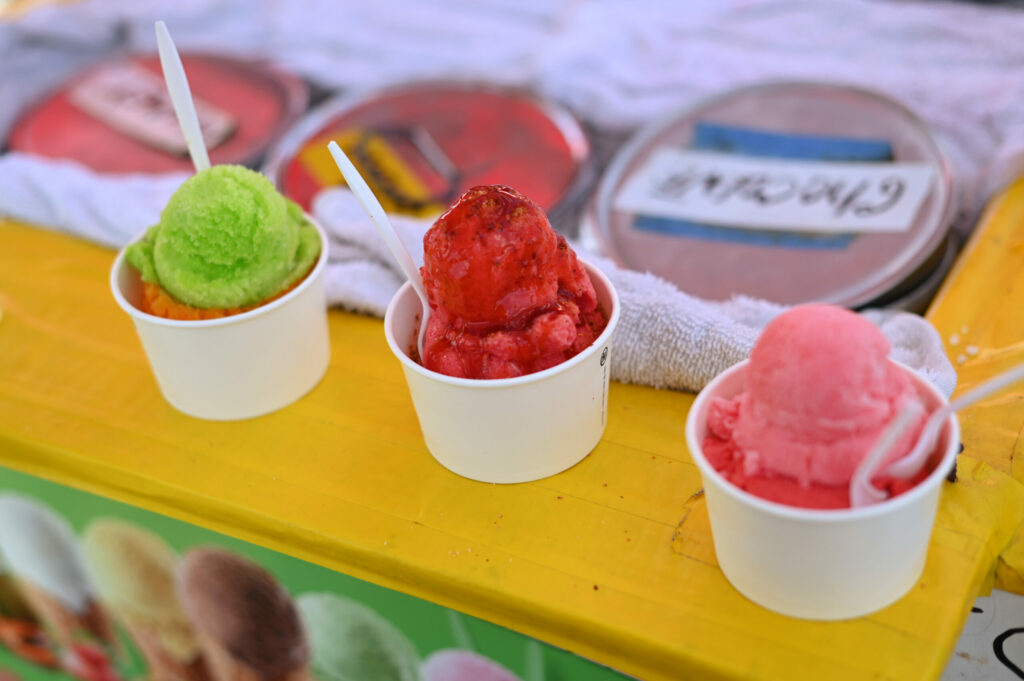
He passes by an orange El Roy’s truck, where he occasionally trades ice cream for tacos, and La Texanita restaurant, where Guy Fieri once filmed an episode of “Diners, Drive-Ins, and Dives.” He nods at a paletero, or popsicle man, in a wide-brimmed hat, pushing a much smaller cart filled with store-bought popsicles that he sells for a few dollars more than he bought them for.
Up and down Sebastopol Road, people are hawking street food, often tamales or other easily carried meals. On busy days outside Chula’s Party Shop, owner Juana Cortes parks a cart with cups of sliced fruit for sale. And at Tortilleria Apatzingan, a woman serves up creamy Jell-O cups. These small-scale entrepreneurs are a tradition that goes back centuries. Years after deeding the property that would become downtown Santa Rosa, local founding father Julio Carrillo scraped by selling his wife’s tamales from a cart in Courthouse Square.
“In Mexico, that’s what you do,” says Suarez, who remembers family stories of his own grandmother selling tacos on the streets. “When you’re trying to make ends meet, you turn to that entrepreneurial spirit, and you sell food.”
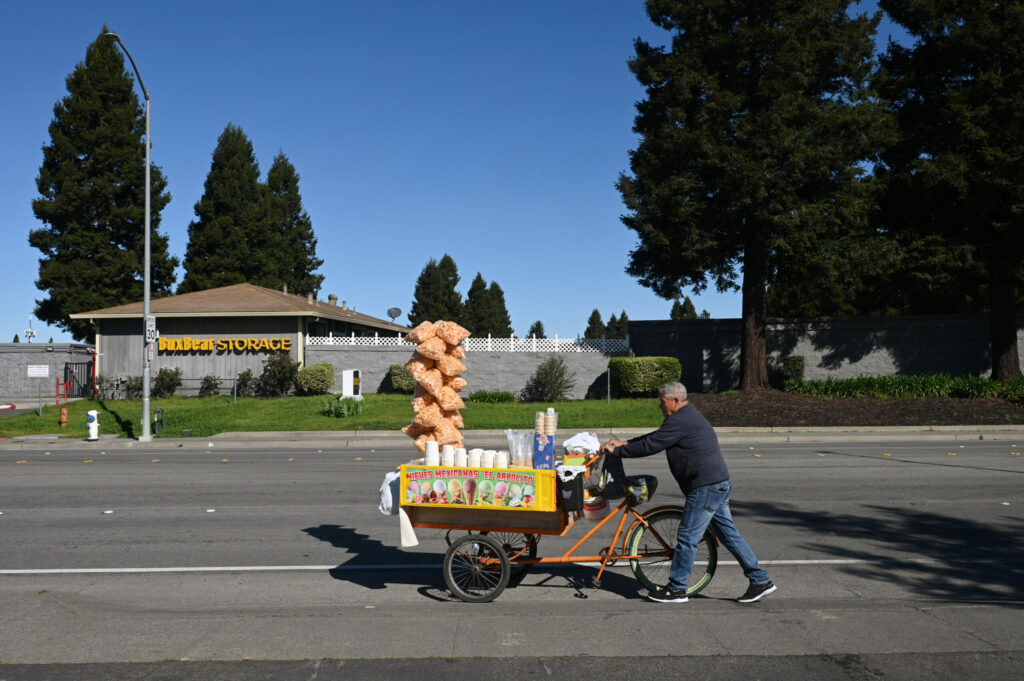
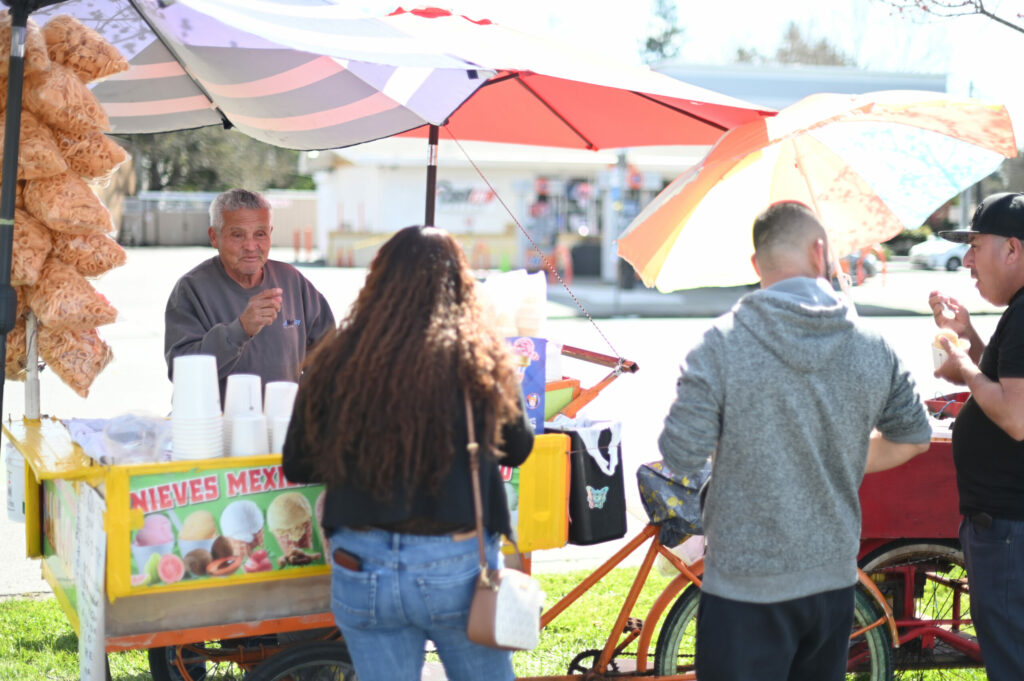
GLANCING OVER HIS SHOULDER, he pushes his cart out into traffic, carving a diagonal line across the road. A line of cars slows to a stop without honking, as if it’s something they see every day. He’s crossing to see the women who work at a local flower shop and a photography store, a halfway point where he can catch his breath and visit with friends. In early May each year, he stops near here to give away free ice cream to children and their mothers. It’s his way of celebrating both el Día del Niño on April 30 and Mexican Mother’s Day on May 10.
A few blocks farther down, he leaves his cart on the sidewalk while he ducks into a small market to buy a half-pound of queso fresco, a serrano chile and an avocado. At his cart, he cuts the fresh ingredients with a knife, rolling them in tortillas for a late lunch.
By the time he reaches the other end of the road, he is tired. He splashes water on his face and wipes his face with the towel again. He rolls the cart into a familiar spot, where the grass is still flattened from the day before, setting up shop in the shade of another lonely little tree. Someone driving by in a car honks and waves, and he waves back. He often buys menudo from Lola’s to take home for dinner. When he does, he gives ice cream to the women who cook it. It’s his way of thanking them.
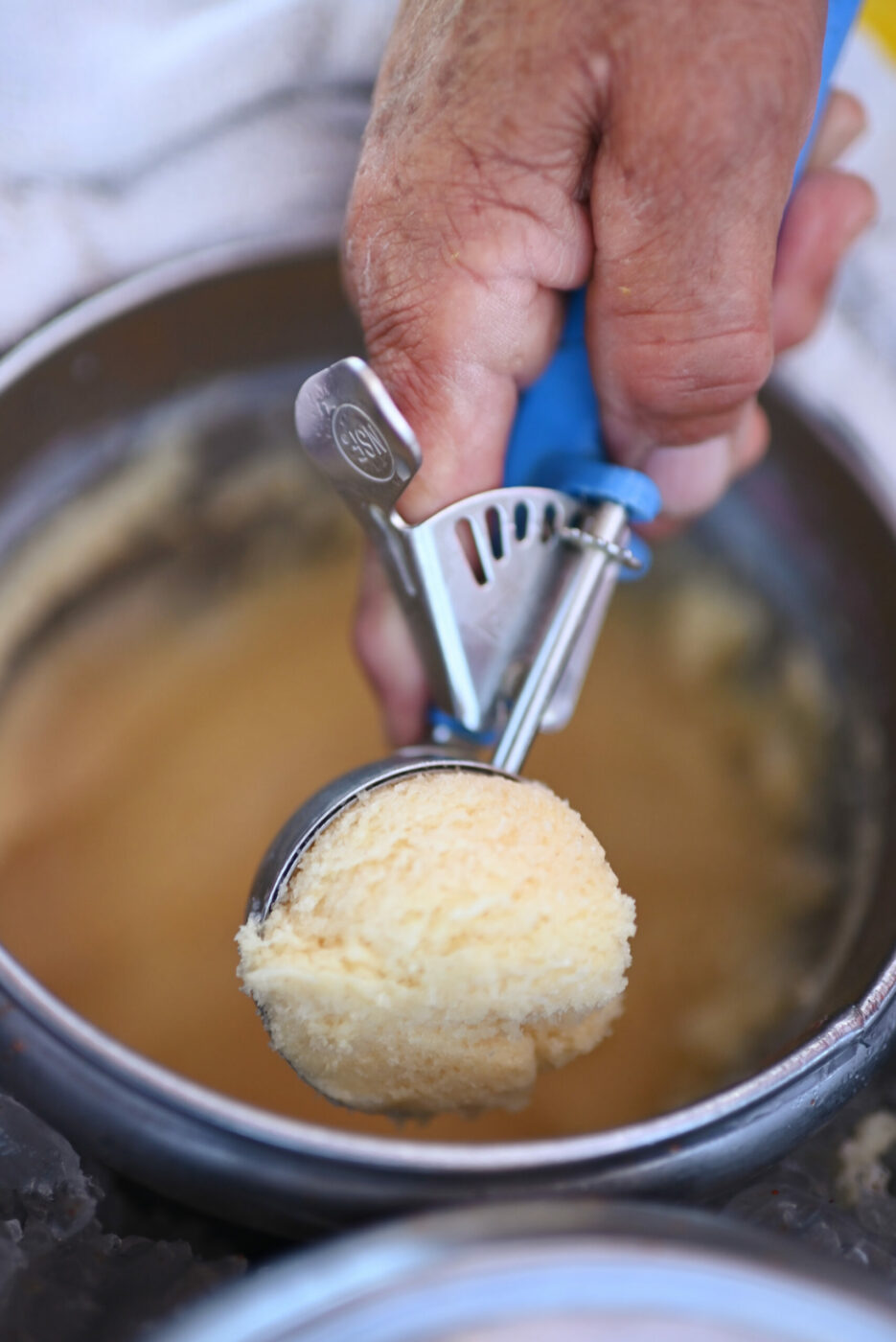
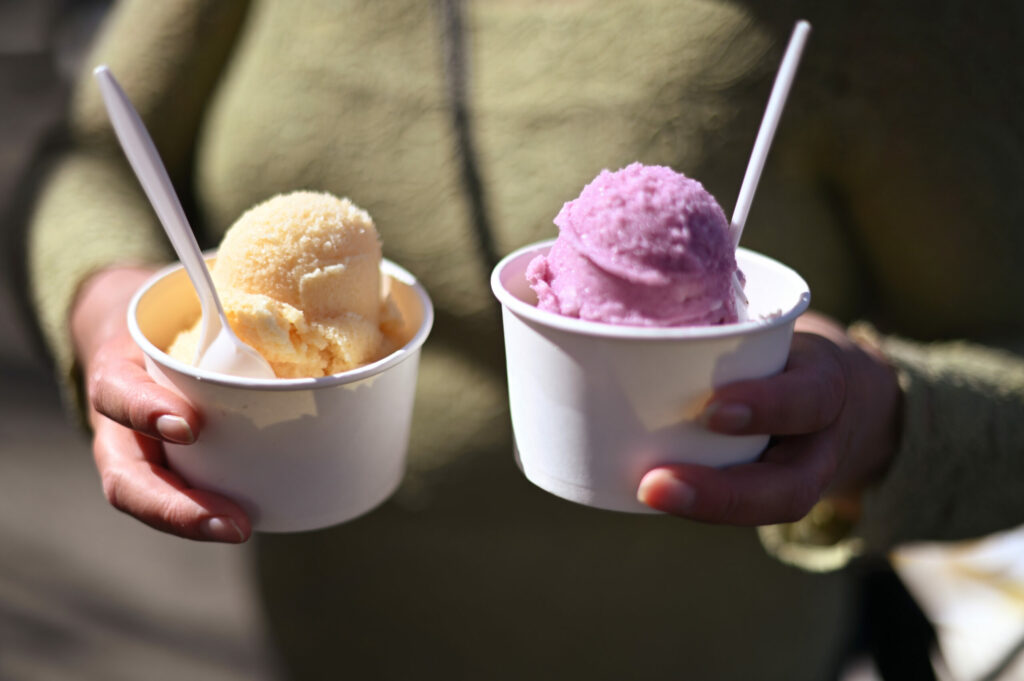
It’s not long before a couple he recognizes stops by. They laugh about how long it’s been since they’ve seen each other. The husband, Jorge, is from Mexico City, and his wife grew up in Patzcuaro, which she says is famous for its ice cream. Both retired, they drove over an hour from Vallejo this day to get food a few blocks away at the Delicias Elenita taco truck, “and to eat this ice cream that we can’t get anywhere else,” Jorge says.
A few days earlier, in his garage, while he offered samples of his ice cream, laid out in a long freezer like you would see inside an ice cream parlor, he shared how loyal customers will log his phone number into their cell phones and call him if he misses a day, asking, “where are you?”
It feels good to be wanted, he says, joking that he might be one of the most popular people in all of Roseland. By now, he realizes, “More than ice cream, I sell happiness.”
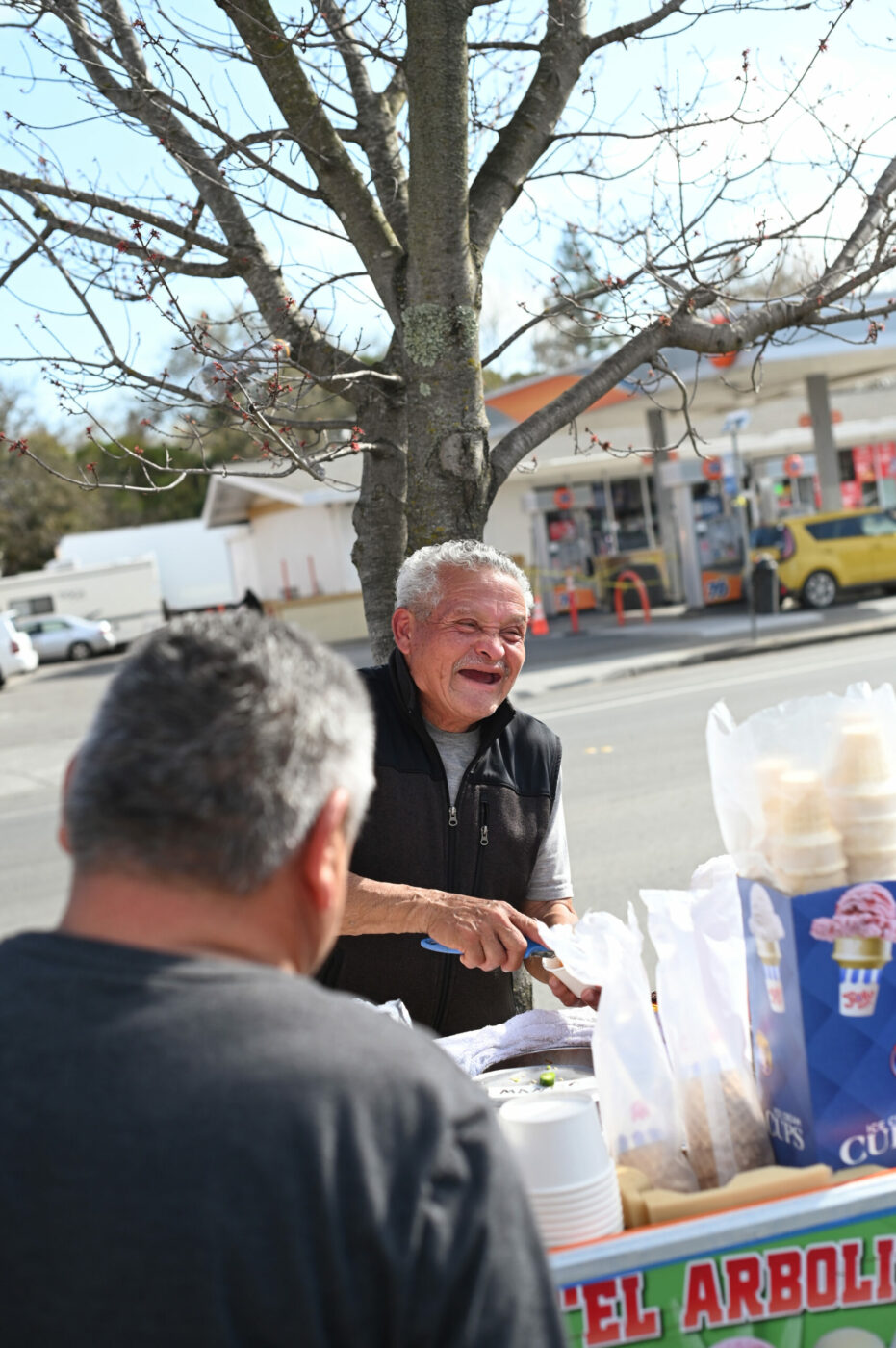
He used to walk up and down Sebastopol Road with his grandson, but his grandson moved to Tijuana. When his wife would work the cart with him, often during popular events like Cinco de Mayo, he used to tease her that her servings were too small. But she died four years ago, and now he lives with his son. His other three children live in Tijuana.
Both of his parents lived into their mid-80s. Now in his 70s, the vendor hopes to work the streets for another decade before he retires. It would be easier on his body if he could get an electric cart, but the $2,500 cost is out of reach for now.
Customers will often ask for his recipes, but he remains tight-lipped. “I tell them, ‘I can sell it you for $80,000,’” he says, laughing. He thinks his recipes will probably die with him. “My children are not interested in selling ice cream. I will take the recipes with me to the grave.”
Looking around at the rush hour crowds coming in and out of Lola’s Market, he talks about how people like to buy ice cream on Friday evenings. But you should see the weekends, he says — that’s the busiest.
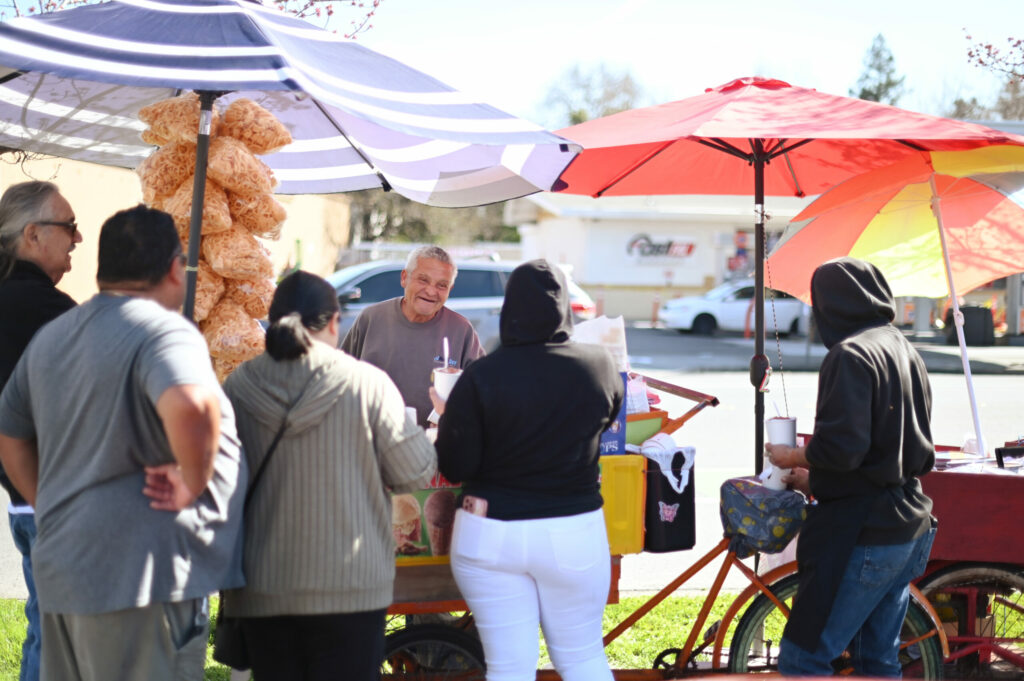
He checks the melting ice with his stick, poking it deeper into the cracks between the buckets and covering it with fresh towels. He’ll sell ice cream until the sun sets, making around $250, and then he’ll make his way back up Sebastopol Road, past the jewelry store, where people line up at 5 a.m. Saturday morning to catch the bus to Michoacán for $240 one way. He’ll pass the altar to Our Lady of Guadalupe, and the spot where several months ago a demonstrator held a sign that read Nadie es ilegal en tierra robada (“No one is illegal on stolen land”).
Then back at home, he will restock his ice cream buckets, fry up a new batch of chicharrones, and fall fast asleep.
Produced by Raquel Issenberg of La Prensa Sonoma.


